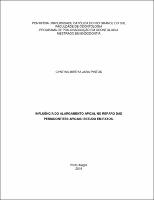| Share record |


|
Please use this identifier to cite or link to this item:
https://tede2.pucrs.br/tede2/handle/tede/6832| Document type: | Dissertação |
| Title: | Influência do alargamento apical no reparo das periodontites apicais : estudo em ratos |
| Author: | Jara Pintos, Cynthia Mireya  |
| Advisor: | Figueiredo, José Antonio Poli de |
| Abstract (native): | Introdução: A instrumentação é considerada uma das etapas mais importantes no tratamento endodôntico. A literatura é inconclusiva quanto ao alargamento ideal de preparação apical, propondo diferentes protocolos e técnicas de instrumentação, principalmente no que tange ao seu efeito no reparo de lesões periapicais. Portanto, o objetivo deste estudo foi avaliar a influência do alargamento apical no reparo dos tecidos periapicais de ratos com periodontite apical induzida. Métodos: Foram utilizados 24 ratos Wistar distribuídos em 03 grupos experimentais. A primeira fase consistiu na indução da formação das lesões periapicais nos primeiros molares inferiores de ambos os lados, deixando os canais radiculares expostos ao meio oral por três semanas. A seguir, no Grupo 01 o preparo pela técnica seriada foi realizado até o instrumento #20, no grupo 02 até #25 e no Grupo 03 até #30. Os canais foram obturados 0,5 mm aquém do forame apical, pela técnica do cone único de guta-percha e cimento AH Plus e posteriormente selados com cimento de ionômero vidro. Após três semanas foi realizada a eutanásia. O reparo periapical foi avaliado através de radiografias digitais e analises histológica e os dados obtidos foram analisados por meio dos testes de ANOVA e Kruskal-Wallis com o objetivo de determinar se o aumento progressivo da preparação apical fornece um benefício adicional na reparação apical. Resultados: Foi observada uma diferença significativa (p≤0,05) no reparo a favor de todos os grupos experimentais quando comparando aos seus respectivos controles. Estes resultados foram respaldados pela analise histológica. Radiograficamente, observou-se leve tendência de melhora na cicatrização periapical para o maior alargamento apical (grupo 3). Conclusão: Nenhuma diferença significativa foi encontrada entre os três grupos experimentais, mas foi possível apreciar radiograficamente uma tendência de melhoria no grupo de maior instrumentação (grupo 3: # 30). |
| Abstract (english): | Introduction: Instrumentation is considered one of the most important steps in endodontic treatment. The literature is controversial with regards to the optimal apical enlargement, especially as to the repair of periapical lesions, proposing different protocols and instrumentation techniques. This study aimed to evaluate the influence of apical enlargement in the process of apical repair in rats. Methods: 24 Wistar rats were divided into 03 experimental groups. Periapical lesion of the first molars on both sides was induced, leaving the root canals exposed to the oral cavity for three weeks. Group 01 consisted of preparation until a #20 file, Group 02 until #25 and Group 03 until #30 file. One molar has been instrumented, while the opposite side was a negative control for apical repair. Root canals were filled 0.5 mm from the apex, with single cone technique of gutta-percha and sealer. After three weeks, the animals were euthanized. Periapical repair was evaluated by digital radiographs and optical microscopy of histological sections (HE) and the data were analyzed using ANOVA test and Kruskal-Wallis test, aiming to establish whether the progressive increase of apical preparation provides an additional benefit in apical repair. Results: Periapical repair was evaluated using digital radiographs. Radiographic limits of the lesions were marked, finding a significant difference (p ≤ 0.05) in the repair in favor of all groups compared to their respective controls. These results were supported by histological analysis. There was a trend towards improvement in the periapical healing for the larger apical enlargement (group 3). Conclusion: No significant difference was found between the three experimental groups, but it was possible to appreciate radiographically an improving trend for the group of more instrumentation (third group: #30). |
| Keywords: | ENDODONTIA TECIDO PERIAPICAL DENTES - RADIOGRAFIA PERIAPICAL PERIODONTIA ODONTOLOGIA |
| CNPQ Knowledge Areas: | CIENCIAS DA SAUDE::ODONTOLOGIA |
| Language: | por |
| Country: | Brasil |
| Publisher: | Pontifícia Universidade Católica do Rio Grande do Sul |
| Institution Acronym: | PUCRS |
| Department: | Faculdade de Odontologia |
| Program: | Programa de Pós-Graduação em Odontologia |
| Access type: | Acesso Aberto |
| URI: | http://tede2.pucrs.br/tede2/handle/tede/6832 |
| Issue Date: | 31-Mar-2016 |
| Appears in Collections: | Programa de Pós-Graduação em Odontologia |
Files in This Item:
| File | Description | Size | Format | |
|---|---|---|---|---|
| DIS_CYNTHIA_MIREYA_JARA_PINTOS_PARCIAL.pdf | Texto Parcial | 362.69 kB | Adobe PDF |  Download/Open Preview |
Items in DSpace are protected by copyright, with all rights reserved, unless otherwise indicated.




